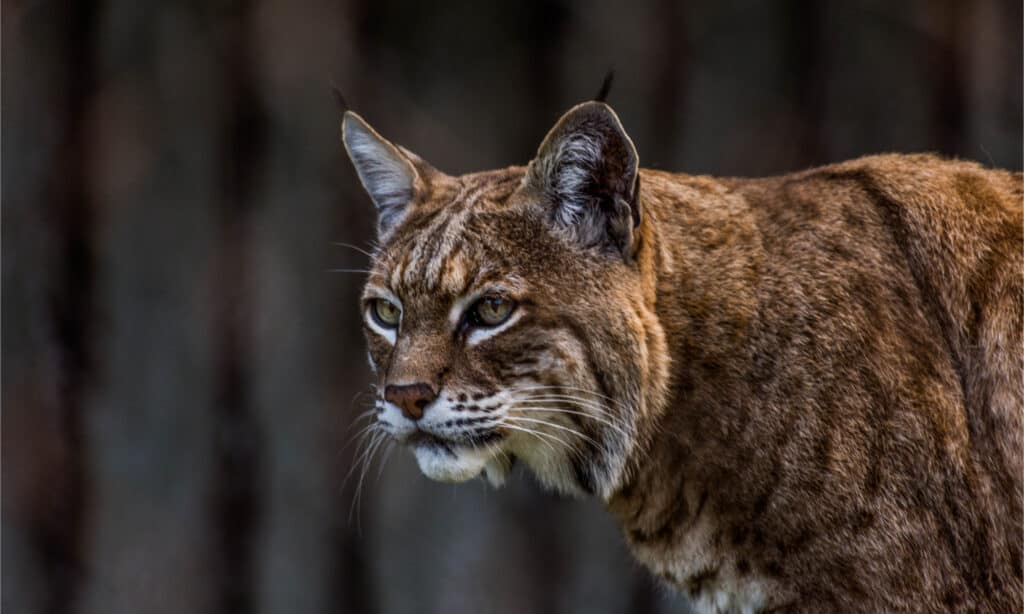Bobcats are the only wild cat found native to Virginia. However, how many bobcats live in Virginia? And where do they live? Learn the answers to these questions and more in this complete guide to bobcats in Virginia.
About Bobcats
The bobcat, also known as the red lynx, is one of the wild cats native to North America along with species like the cougar. It can be found as far north as Canada, throughout the United States, and as far south as the State of Oaxaca in Mexico. The scientific name for the bobcat is Lynx rufus. As of 2017, there are two official subspecies of bobcats: L. r. Rufus, which is found east of the Great Plains, and L. r. Fasciatus, which is found west of the Great Plains.
The bobcat is the smallest of the four main species found in the Lynx genus. However, it is still a mid-sized predator, typically appearing larger than your average house cat. They can grow to be anywhere from around 18 to 50 inches from the snout to the base of their tail, which is stubby like a Manx cat. It sports a brownish coloration that varies in hue along with a spotted pattern. This helps camouflage the bobcat.
Like other wild cats, the bobcat has a distinct paw print. This is because, thanks to their retractable claws, their tracks lack any notable claw marks, unlike canine species. Their tracks range from one to three inches in size, slightly smaller than the mountain lion’s.

©Don Mammoser/Shutterstock.com
Bobcats in Virginia: Population
The only wild cats native to Virginia are bobcats. Because of their clandestine, solitary nature, it can be hard to garner enough information to make a perfectly accurate estimate of their population in Virginia. However, thanks to countless hours of research by scientists throughout the state, we are able to make estimates on just how many bobcats may call Virginia home.
It is estimated that there are 3.6 million bobcats found throughout the nation. Being well-established in Virginia, you can expect to find hundreds, if not thousands, of individual bobcats living in Virginia.
Where do bobcats live in Virginia?
The bobcat is a highly adaptable species. Because of this, they’re able to survive and thrive in a variety of habitats. This includes everything from forests to swamps to plains. They prefer to live in woodland areas, but they’re not as common in deep, dense forests. Despite their adaptability, however, they’re unable to live in solely urban environments. Most encounters in human habitats occur in areas that coincide with animal habitats, such as in the suburbs or in rural areas.
Despite being skilled and fierce hunters, bobcats aren’t actually interested in interacting with humans. Instead, they prefer to stick to less inhabited areas and avoid humans whenever possible. If they happen to wind up misfortunate enough to be chased by loose dogs, rather than fight, bobcats will prefer to climb trees in nearby areas.
They are nocturnal and cannot typically be seen during the height of the day. They can be found in permanent dens during the spring months when they are raising their kittens.

© Johann Knox/Shutterstock.com
Have bobcats attacked people in Virginia?
Bobcat attacks are extremely rare. This is because bobcats don’t see us as prey, and when it comes to threats, they’re more adept at fleeing than fighting head-on. However, that doesn’t mean there has never been a bobcat attack in Virginia. In fact, in October 2021, three people were attacked in a single incident with a bobcat in Virginia.
Another bobcat was later struck and killed by a vehicle, although it is unknown if this was the same bobcat involved in the attack. The bobcat killed in the collision, however, tested positive for rabies, which can greatly alter an animal’s perception and behavior.
Laws Related to Bobcats in Virginia
As a species of least concern, there are few laws related to bobcats in Virginia. If you go through the process of purchasing and receiving the right permit, you will be able to hunt them. However, it is unlawful to own or otherwise purchase a bobcat to keep as an exotic pet.
Despite their cute, cuddly appearance, bobcats are wild animals and predators. As a result, no matter the circumstances, they have the ability to act as such. This means that, although it can be tempting, keeping a bobcat as a pet in the state of Virginia isn’t just unlawful, but it’s dangerous.

©Victor Arita/Shutterstock.com
What To Do If You See A Bobcat in Virginia
Bobcat attacks are rare. However, it’s still important to handle chance encounters properly. Never let a bobcat in your yard or where you are without scaring it. Make yourself larger by spreading your legs more than shoulder length apart and waving your arms above your head. You can also yell and clap.
Not only does this help reduce the chance of a negative encounter, but it can also keep the bobcat safe. Bobcats that grow too used to humans and no longer see them as a threat or danger can harm themselves or others.
The post Bobcats in Virginia: How Many Are There and Where Do They Roam? appeared first on AZ Animals.
from Animal News, Facts, Rankings, and More! - AZ Animals https://ift.tt/UAeGWHc